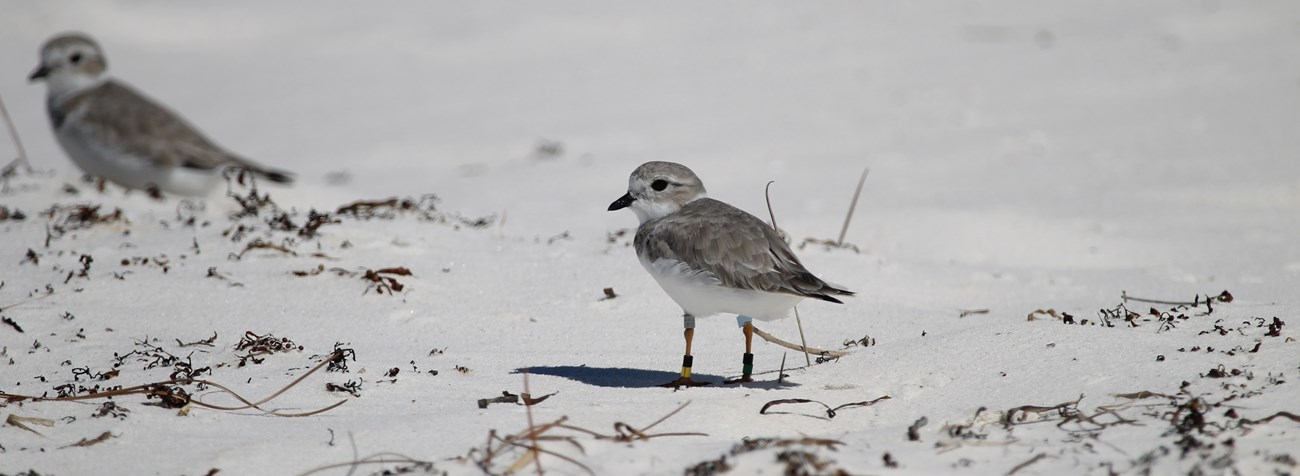
NPS Photo The piping plover, Charadrius melodus, is a migratory bird species currently decreasing in numbers. During the spring and summer piping plovers breed in the northern United States and Canada. Not unlike humans, as winter approaches and the weather cools, piping plovers seek the warmer climates of the southern Atlantic and Gulf coasts. These preferred wintering grounds, include the sand flats of Gulf Islands National Seashore! Breeding piping plover have eye-catching features. These include a black bill with an orange base, a black band across the forehead, a narrow black band just below their neck, and bright orange legs. However, it takes a keen eye to distinguish the piping plover from other shore birds when visiting the seashore during the winter. Throughout the non-breeding season they lose the black bands on the head and neck and take on a slightly muted appearance, with only a dull blackish bill and faded orange legs to identify them. While observing piping plovers near the water’s edge you may notice them quickly run a short distance, pause, and then run again. When they spot something edible during a pause they will quickly peck at the ground, eating a variety of prey, before moving on. The diet of the piping plover includes insects, marine invertebrates, and crustaceans. Piping plovers have also been observed holding one foot out in front of their bodies and quickly shuffling it in the sand, startling prey to the surface where they can easily grab them. Amazingly, piping plover chicks can forage for food on their own only an hour or two after they hatch! Male piping plovers perform courtship dances both in the air and on land. In the air, males circle or perform figure eights over a breeding territory. Once on land the male often whistles, crouches, circles the female, spreads his wings and tail, and then with puffed feathers, an outstretched neck, and holding his head up high, he stamps his feet before mating. Piping plovers nest well above the high-tide line in areas called scrapes. A scrape is a shallow hole with a rim just deep enough to keep the eggs from rolling away. Male piping plovers will scratch several scrapes to claim their territory. Female piping plovers will pick one of the scrapes and lay four small camouflaged eggs, one every other day. Both the males and females participate in incubation, which usually takes just under a month. Unfortunately for the piping plovers, they breed and winter in locations most coveted by humans. The eastern seaboard, Great Lakes, and Gulf of Mexico are some of the most desirable locations for development and recreation. This conflict between the natural range, wintering locations, and migratory patterns of piping plovers and human enjoyment has led to extensive habitat loss, bringing this species close to extinction. Vehicles on the beach, pets, foxes and crows are also among the most serious threats to this species’ survival. Luckily, even though a pair of nesting piping plovers will only raise one brood of chicks per breeding season, a female will lay additional clutches if the nest is destroyed. Biologists at Gulf Islands National Seashore, along with other scientists, participate in range-wide banding efforts to help identify and track the habits of piping plovers. By placing tiny colored bracelet-like bands on the legs of the birds, biologists can learn specific information about individual birds. In one case, a 20-day old chick was banded at a housing development in Nebraska and was then observed nesting in North Dakota the following year. That same piping plover was also observed on various occasions in the non-breeding season at Fort Pickens and Perdido Key. These efforts by the National Park Service and the scientific community aim to protect this species and its habitats, but we need your help. You can be a part of this species survival story by not driving on the beach, observing beach closure notices, and keeping your pets on a six foot lead on approved beaches only.
|
Last updated: February 19, 2020
